Tetris Played On MIT's Green Building Is YouTube Hit [VIDEO]

MIT's Green Building was the canvas for a playable Tetris game in this amazing video that has become a YouTube sensation, amassing more than 500,000 views in less than a week.
Video of Tetris being played on MIT's green building can be viewed by scrolling further down in this article.
It's unclear whether MIT condones the behavior, but previous pranks in the past, also called hacks, were not approved by the MIT administation according to the MIT Gallery of Hacks website.
Hackers who are caught may face legal penalties and fines. Still, this does not stop the administration from appreciating a good hack -- after the fact, the MIT Gallery of Hacks FAQ page says.
It's unclear who is behind the shenanigans.
Hackers pride themselves in making these kinds of things happen while leaving the MIT community guessing who did it and how, says the MIT Hack Gallery FAQ page. Consequently, one seldom knows who is responsible. Sometimes a 'hacking group' will take credit for a particular hack.
MIT's Green Building, formally known as Building 54, houses the Massachusetts school's Earth and Planetary Sciences Department.
The building's façade was used as the canvas for a playable Tetris game, with a console used to allow players to move, rotate and drop blocks just like the classic video game.
MIT hackers have long considered 'Tetris on the Green Building' to be the Holy Grail of hacks, as the side of the building is a wonderful grid for the game, the MIT Hack Gallery site wrote.
The game began with the word Tetris scrolling down the building, followed by the first level of the game. Early levels had the blocks consisting of darker colors and the late stages had paler colors that made it harder to form Tetris lines.
The Tetris On The Green Building hack is the fourth MIT hack conducted this year. The tradition began in 1989, when the Athena workstation that MIT students logged onto contained a fuzzball instead of the normal Athena Owl character.
© Copyright IBTimes 2024. All rights reserved.






















